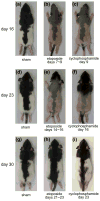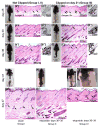A novel rat model for chemotherapy-induced alopecia
- PMID: 22409523
- PMCID: PMC3305180
- DOI: 10.1111/j.1365-2230.2011.04239.x
A novel rat model for chemotherapy-induced alopecia
Abstract
Background: More than half of all people diagnosed with cancer receive chemotherapy, and approximately 65% of these develop chemotherapy-induced alopecia (CIA), a side-effect that can have considerable negative psychological repercussions. Currently, there are very few animal models available to study the mechanism and prevention of CIA.
Aim: To develop a clinically relevant adult rat model for CIA.
Methods: We first tested whether neonatal pigmented Long-Evans (LE) rats developed alopecia in response to the chemotherapeutic agents etoposide and cyclophosphamide. We then determined whether the rats developed CIA as adults. In the latter experiment, rat dorsal hair was clipped during the early telogen stage to synchronize the hair cycle, and starting 15 days later, the rats were treated with etoposide for 3 days.
Results: Neonatal LE pups developed CIA in response to etoposide and cyclophosphamide, similar to other murine models for CIA. Clipping of the hair shaft during early telogen resulted in synchronized anagen induction and subsequent alopecia after etoposide treatment in the clipped areas only. Hair follicles in the clipped areas had the typical chemotherapy-induced follicular dystrophy (dystrophic catagen). When the hair in the pigmented alopecic areas regrew, it had normal pigmentation.
Conclusions: A novel, pigmented adult rat model has been established for CIA. By hair-shaft clipping during early telogen, synchronized anagen entry was induced, which resulted in alopecia in response to chemotherapy. This is the first clinically relevant adult rat model for CIA, and will be a useful tool to test agents for the prevention and treatment of CIA.
© The Author(s). CED © 2012 British Association of Dermatologists.
Conflict of interest statement
Conflict of interest: none declared.
Figures


References
-
- Wang J, Lu Z, Au JL. Protection against chemotherapy-induced alopecia. Pharm Res. 2006;23:2505–14. - PubMed
-
- Trüeb RM. Chemotherapy-induced alopecia. Semin Cutan Med Surg. 2009;28:11–14. - PubMed
-
- Hesketh PJ, Batchelor D, Golant M, et al. Chemotherapy-induced alopecia: psychosocial impact and therapeutic approaches. Support Care Cancer. 2004;12:543–9. - PubMed
-
- Lemieux J, Maunsell E, Provencher L. Chemotherapy-induced alopecia and effects on quality of life among women with breast cancer: a literature review. Psychooncology. 2008;17:317–28. - PubMed
-
- Hussein AM, Jimenez JJ, McCall CA, Yunis AA. Protection from chemotherapy-induced alopecia in a rat model. Science. 1990;249:1564–6. - PubMed
Publication types
MeSH terms
Substances
Grants and funding
LinkOut - more resources
Full Text Sources
Other Literature Sources

